Polyelectrolyte Microcapsules—A Promising Target Delivery System of Amiodarone with the Possibility of Prolonged Release
Abstract
1. Introduction
2. Results and Discussions
2.1. Am:MASGA Incorporating into CaCO3 Microspherulites
2.2. Encapsulation of Am:MASGA by Adsorption into CaCO3 Microspherulites Coated with a Polyelectrolyte Shell
2.3. Encapsulation of Am:MASGA by Adsorption into Polyelectrolyte Microcapsules (PAH/PSS)n
3. Materials and Methods
3.1. Materials
3.2. Capturing of Amiodarone by CaCO3 by Co-Precipitation Method
3.3. Capturing of Amiodarone by CaCO3 by Adsorption Method
3.4. Encapsulation of Amiodarone in Polyelectrolyte Microcapsules with Undissolved CaCO3 Core (CaCO3/PAH/PSS)n
3.5. Encapsulation of Amiodarone in Polyelectrolyte Microcapsules with Dissolved CaCO3 Core (PAH/PSS)n
3.6. Determination of Amiodarone Concentration Released from Different Types of Carriers
3.7. Statistical Processing
4. Conclusions
Author Contributions
Funding
Institutional Review Board Statement
Informed Consent Statement
Data Availability Statement
Conflicts of Interest
References
- Falk, R.H. Atrial Fibrillation. N. Engl. J. Med. 2001, 344, 1067–1078. [Google Scholar] [CrossRef] [PubMed]
- January, C.T.; Wann, L.S.; Calkins, H.; Chen, L.Y.; Cigarroa, J.E.; Cleveland, J.C.; Ellinor, P.T.; Ezekowitz, M.D.; Field, M.E.; Furie, K.L.; et al. 2019 AHA/ACC/HRS Focused Update of the 2014 AHA/ACC/HRS Guideline for the Management of Patients with Atrial Fibrillation: A Report of the American College of Cardiology/American Heart Association Task Force on Clinical Practice Guidelines and the Heart R. Circulation 2019, 140, e125–e151. [Google Scholar] [CrossRef] [PubMed]
- Sagris, M.; Vardas, E.P.; Theofilis, P.; Antonopoulos, A.S.; Oikonomou, E.; Tousoulis, D. Atrial Fibrillation: Pathogenesis, Predisposing Factors, and Genetics. Int. J. Mol. Sci. 2021, 23, 6. [Google Scholar] [CrossRef] [PubMed]
- Mozaffarian, D.; Benjamin, E.J.; Go, A.S.; Arnett, D.K.; Blaha, M.J.; Cushman, M.; de Ferranti, S.; Després, J.-P.; Fullerton, H.J.; Howard, V.J.; et al. Heart Disease and Stroke Statistics—2015 Update. Circulation 2015, 131, e29–e322. [Google Scholar] [PubMed]
- Benjamin, E.J.; Levy, D.; Vaziri, S.M.; D’Agostino, R.B.; Belanger, A.J.; Wolf, P.A. Independent risk factors for atrial fibrillation in a population-based cohort. The Framingham Heart Study. JAMA 1994, 271, 840–844. [Google Scholar]
- Alonso, A.; Almuwaqqat, Z.; Chamberlain, A. Mortality in atrial fibrillation. Is it changing? Trends Cardiovasc. Med. 2021, 31, 469–473. [Google Scholar] [CrossRef]
- Golzari, H. Atrial Fibrillation: Restoration and Maintenance of Sinus Rhythm and Indications for Anticoagulation Therapy. Ann. Intern. Med. 1996, 125, 311. [Google Scholar]
- Kannel, W.; Wolf, P.; Benjamin, E.; Levy, D. Prevalence, incidence, prognosis, and predisposing conditions for atrial fibrillation: Population-based estimates 11Reprints are not available. Am. J. Cardiol. 1998, 82, 2N–9N. [Google Scholar] [CrossRef]
- Ruigómez, A.; Johansson, S.; Wallander, M.-A.; García Rodríguez, L.A. Risk of mortality in a cohort of patients newly diagnosed with chronic atrial fibrillation. BMC Cardiovasc. Disord. 2002, 2, 5. [Google Scholar]
- Amin, A.N.; Jhaveri, M.; Lin, J. Incremental cost burden to US healthcare payers of atrial fibrillation/atrial flutter patients with additional risk factors. Adv. Ther. 2011, 28, 907–926. [Google Scholar]
- Kim, M.H.; Johnston, S.S.; Chu, B.-C.; Dalal, M.R.; Schulman, K.L. Estimation of Total Incremental Health Care Costs in Patients with Atrial Fibrillation in the United States. Circ. Cardiovasc. Qual. Outcomes 2011, 4, 313–320. [Google Scholar] [PubMed]
- Iqbal, M.B.; Taneja, A.K.; Lip, G.Y.H.; Flather, M. Recent developments in atrial fibrillation. BMJ 2005, 330, 238–243. [Google Scholar] [CrossRef] [PubMed]
- Mujović, N.; Dobrev, D.; Marinković, M.; Russo, V.; Potpara, T.S. The role of amiodarone in contemporary management of complex cardiac arrhythmias. Pharmacol. Res. 2020, 151, 104521. [Google Scholar] [CrossRef] [PubMed]
- Marcus, F.I.; Fontaine, G.H.; Frank, R.; Grosgogeat, Y. Clinical pharmacology and therapeutic applications of the antiarrhythmic agent, amiodarone. Am. Heart J. 1981, 101, 480–493. [Google Scholar] [CrossRef]
- Zipes, D.P.; Prystowsky, E.N.; Heger, J.J. Amiodarone: Electrophysiologic actions, pharmacokinetics and clinical effects. J. Am. Coll. Cardiol. 1984, 3, 1059–1071. [Google Scholar]
- Valembois, L.; Audureau, E.; Takeda, A.; Jarzebowski, W.; Belmin, J.; Lafuente-Lafuente, C. Antiarrhythmics for maintaining sinus rhythm after cardioversion of atrial fibrillation. Cochrane Database Syst. Rev. 2019, 2019, CD005049. [Google Scholar] [CrossRef]
- Feduska, E.T.; Thoma, B.N.; Torjman, M.C.; Goldhammer, J.E. Acute Amiodarone Pulmonary Toxicity. J. Cardiothorac. Vasc. Anesth. 2021, 35, 1485–1494. [Google Scholar]
- Trohman, R.G.; Sharma, P.S.; McAninch, E.A.; Bianco, A.C. Amiodarone and thyroid physiology, pathophysiology, diagnosis and management. Trends Cardiovasc. Med. 2019, 29, 285–295. [Google Scholar]
- Candinas, R.; Frielingsdorf, J.; Ha, H.R.; Carrel, T.; Turina, M.; Follath, F. Myocardial amiodarone concentrations after short- and long-term treatment in patients with end-stage heart failure. Eur. J. Clin. Pharmacol. 1998, 53, 331–336. [Google Scholar]
- Adams, P.C.; Holt, D.W.; Storey, G.C.; Morley, A.R.; Callaghan, J.; Campbell, R.W. Amiodarone and its desethyl metabolite: Tissue distribution and morphologic changes during long-term therapy. Circulation 1985, 72, 1064–1075. [Google Scholar] [CrossRef]
- Primeau, R.; Agha, A.; Giorgi, C.; Shenasa, M.; Nadeau, R. Long term efficacy and toxicity of amiodarone in the treatment of refractory cardiac arrhythmias. Can. J. Cardiol. 1989, 5, 98–104. [Google Scholar]
- Pathmanathan, A.; Cleary, L. Amiodarone-Associated Neurotoxicity. Am. J. Ther. 2021, 28, e165–e166. [Google Scholar] [PubMed]
- Garcia, J.R.; Campbell, P.F.; Kumar, G.; Langberg, J.J.; Cesar, L.; Deppen, J.N.; Shin, E.Y.; Bhatia, N.K.; Wang, L.; Xu, K.; et al. Minimally Invasive Delivery of Hydrogel-Encapsulated Amiodarone to the Epicardium Reduces Atrial Fibrillation. Circ. Arrhythmia Electrophysiol. 2018, 11, e006408. [Google Scholar] [CrossRef] [PubMed]
- Bockeria, O.L.; Kanametov, T.N.; Shvartz, V.A.; Sokolskaya, M.A.; Zhuginisov, D.S.; Sanakoev, M.K.; Bockeria, L.A. Epicardial Application of Hydrogel with Amiodarone for Prevention of Postoperative Atrial Fibrillation in Patients After Coronary Artery Bypass Grafting. J. Cardiovasc. Transl. Res. 2020, 13, 191–198. [Google Scholar] [PubMed]
- Ahmed, M.S.; Rodell, C.B.; Hulsmans, M.; Kohler, R.H.; Aguirre, A.D.; Nahrendorf, M.; Weissleder, R. A Supramolecular Nanocarrier for Delivery of Amiodarone Anti-Arrhythmic Therapy to the Heart. Bioconjug. Chem. 2019, 30, 733–740. [Google Scholar] [CrossRef]
- Zhuge, Y.; Xie, M.-Q.; Li, L.; Wang, F.; Gao, F.; Zheng, Z.-F. Preparation of liposomal amiodarone and investigation of its cardiomyocyte-targeting ability in cardiac radiofrequency ablation rat model. Int. J. Nanomed. 2016, 11, 2359. [Google Scholar]
- Johnston, A.P.R.; Cortez, C.; Angelatos, A.S.; Caruso, F. Layer-by-layer engineered capsules and their applications. Curr. Opin. Colloid Interface Sci. 2006, 11, 203–209. [Google Scholar]
- De Geest, B.G.; De Koker, S.; Sukhorukov, G.B.; Kreft, O.; Parak, W.J.; Skirtach, A.G.; Demeester, J.; De Smedt, S.C.; Hennink, W.E. Polyelectrolyte microcapsules for biomedical applications. Soft Matter 2009, 5, 282–291. [Google Scholar] [CrossRef]
- Sukhorukov, B.I.; Tikhonenko, S.A.; Saburova, E.A.; Dubrovsky, A.V.; Dybovskaya, L.N.; Shabarchina, L.I. Encapsulation of enzymes in polyelectrolyte nano- and microcapsules in connection with the problem of microdiagnostics. Biophysics 2007, 52, 1041–1048. [Google Scholar]
- Kochetkova, O.Y.; Kazakova, L.I.; Moshkov, D.A.; Vinokurov, M.G.; Shabarchina, L.I. Incorporation of proteins into polyelectrolyte microcapsules by coprecipitation and adsorption. Russ. J. Bioorganic Chem. 2013, 39, 504–509. [Google Scholar]
- Volodkin, D.V.; Petrov, A.I.; Prevot, M.; Sukhorukov, G.B. Matrix Polyelectrolyte Microcapsules: New System for Macromolecule Encapsulation. Langmuir 2004, 20, 3398–3406. [Google Scholar] [CrossRef] [PubMed]
- Musin, E.V.; Kim, A.L.; Dubrovskii, A.V.; Tikhonenko, S.A. New sight at the organization of layers of multilayer polyelectrolyte microcapsules. Sci. Rep. 2021, 11, 14040. [Google Scholar] [CrossRef] [PubMed]
- Won, Y.-H.; Jang, H.S.; Chung, D.-W.; Stanciu, L.A. Multifunctional calcium carbonate microparticles: Synthesis and biological applications. J. Mater. Chem. 2010, 20, 7728. [Google Scholar] [CrossRef]
- Kazakova, L.; Dubrovskiĭ, A.V.; Moshkov, D.; Shabarchina, L.I.; Sukhorukov, B.I. An electron microscopy study of the structure of polyelectrolyte microcapsules containing protein and containing no protein. Biofizika 2007, 52, 850–854. [Google Scholar] [PubMed]
- Grassi, M.; Grassi, G.; Lapasin, R.; Colombo, I. Understanding Drug Release and Absorption Mechanisms; CRC Press: Boca Raton, FL, USA, 2006; ISBN 9780429129278. [Google Scholar]
- Antipov, A.A.; Shchukin, D.; Fedutik, Y.; Petrov, A.I.; Sukhorukov, G.B.; Möhwald, H. Carbonate microparticles for hollow polyelectrolyte capsules fabrication. Colloids Surf. Physicochem. Eng. Asp. 2003, 224, 175–183. [Google Scholar]
- Bahrom, H.; Goncharenko, A.A.; Fatkhutdinova, L.I.; Peltek, O.O.; Muslimov, A.R.; Koval, O.Y.; Eliseev, I.E.; Manchev, A.; Gorin, D.; Shishkin, I.I.; et al. Controllable Synthesis of Calcium Carbonate with Different Geometry: Comprehensive Analysis of Particle Formation, Cellular Uptake, and Biocompatibility. ACS Sustain. Chem. Eng. 2019, 7, 19142–19156. [Google Scholar] [CrossRef]
- Oral, Ç.M.; Ercan, B. Influence of pH on morphology, size and polymorph of room temperature synthesized calcium carbonate particles. Powder Technol. 2018, 339, 781–788. [Google Scholar]
- Dubrovskii, A.V.; Shabarchina, L.I.; Kim, Y.A.; Sukhorukov, B.I. Influence of the temperature on polyelectrolyte microcapsules: Light scattering and confocal microscopy data. Russ. J. Phys. Chem. A 2006, 80, 1703–1707. [Google Scholar]
- Musin, E.V.; Dubrovskii, A.V.; Kim, A.L.; Tikhonenko, S.A. A Study of the Buffer Capacity of Polyelectrolyte Microcapsules Depending on Their Concentration and the Number of Layers of the Polyelectrolyte Shell. Int. J. Mol. Sci. 2022, 23, 9917. [Google Scholar]
- Petrov, A.I.; Volodkin, D.V.; Sukhorukov, G.B. Protein-Calcium Carbonate Coprecipitation: A Tool for Protein Encapsulation. Biotechnol. Prog. 2008, 21, 918–925. [Google Scholar]
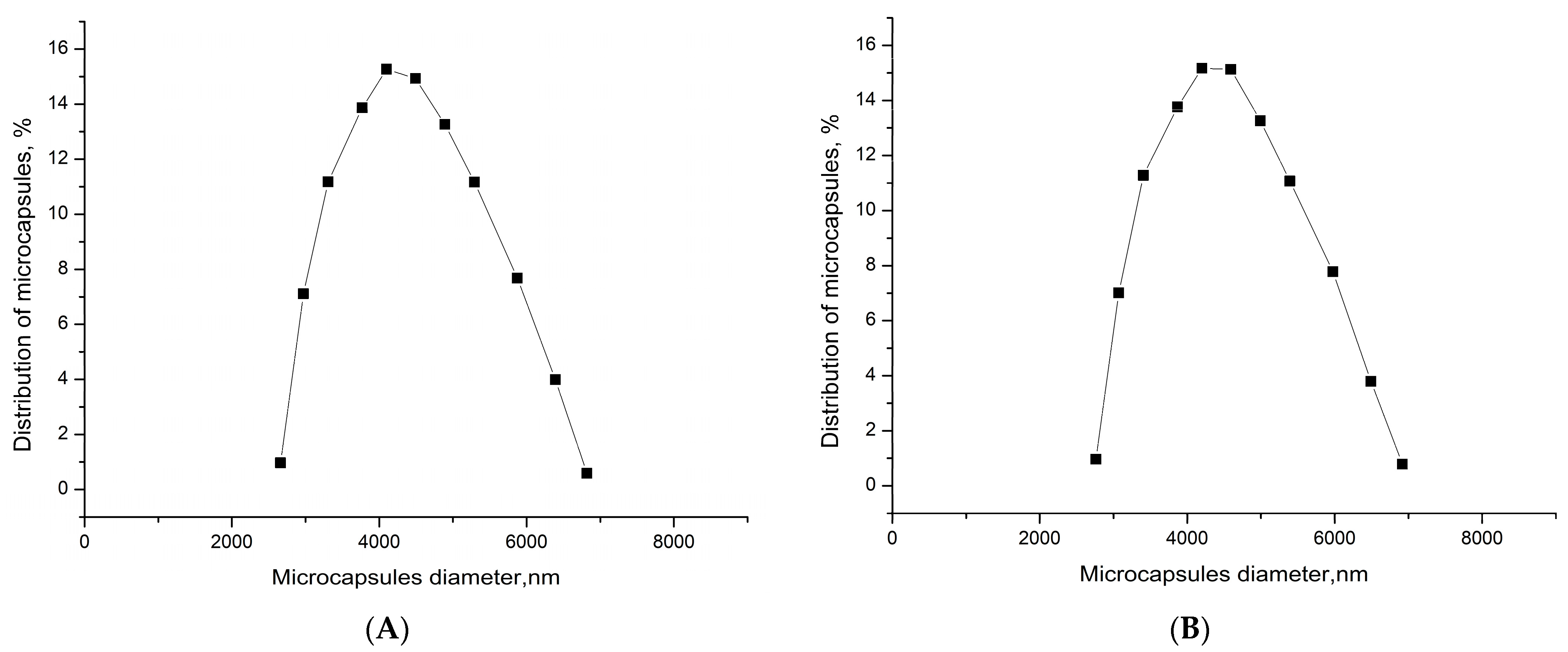
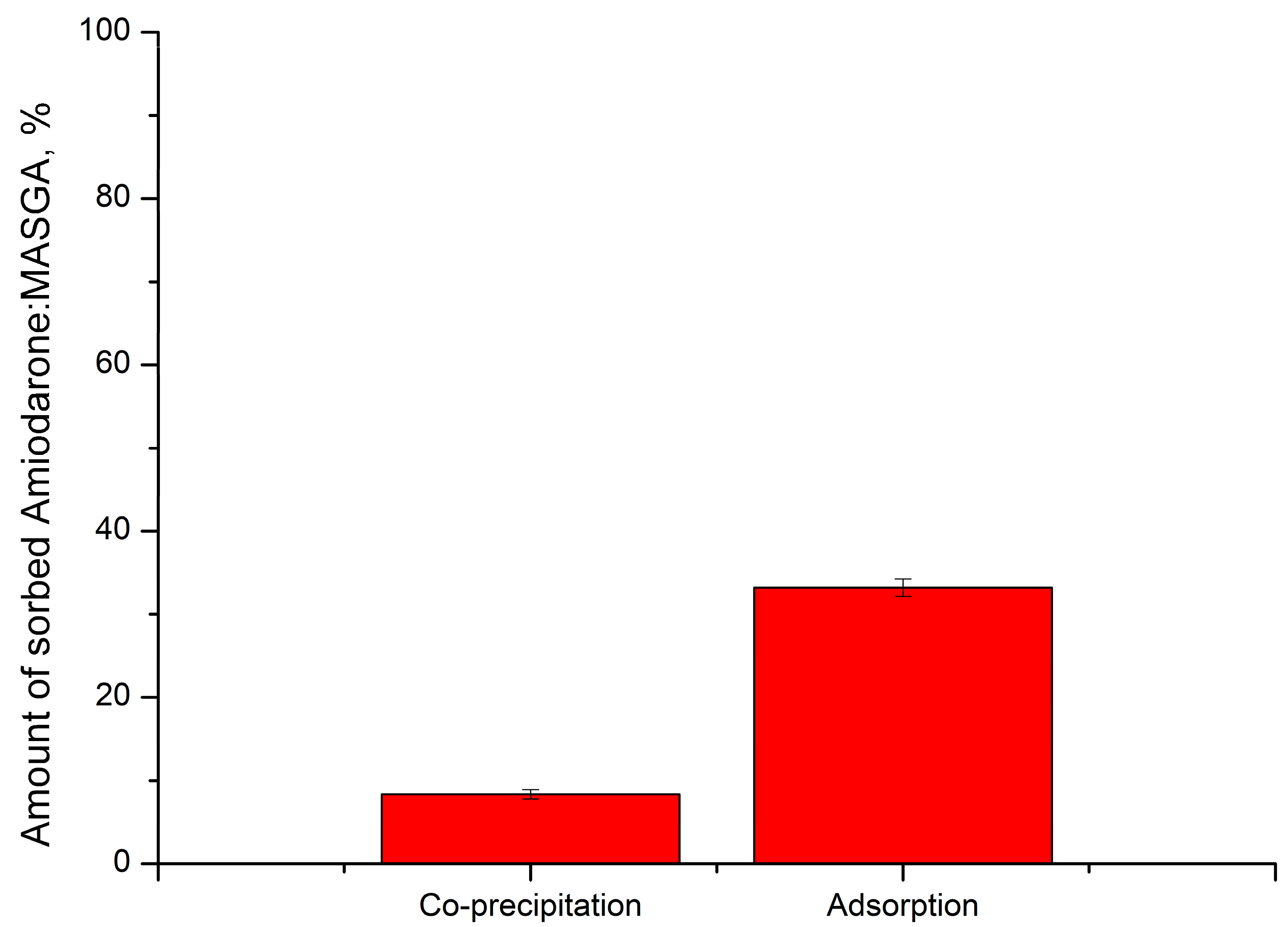

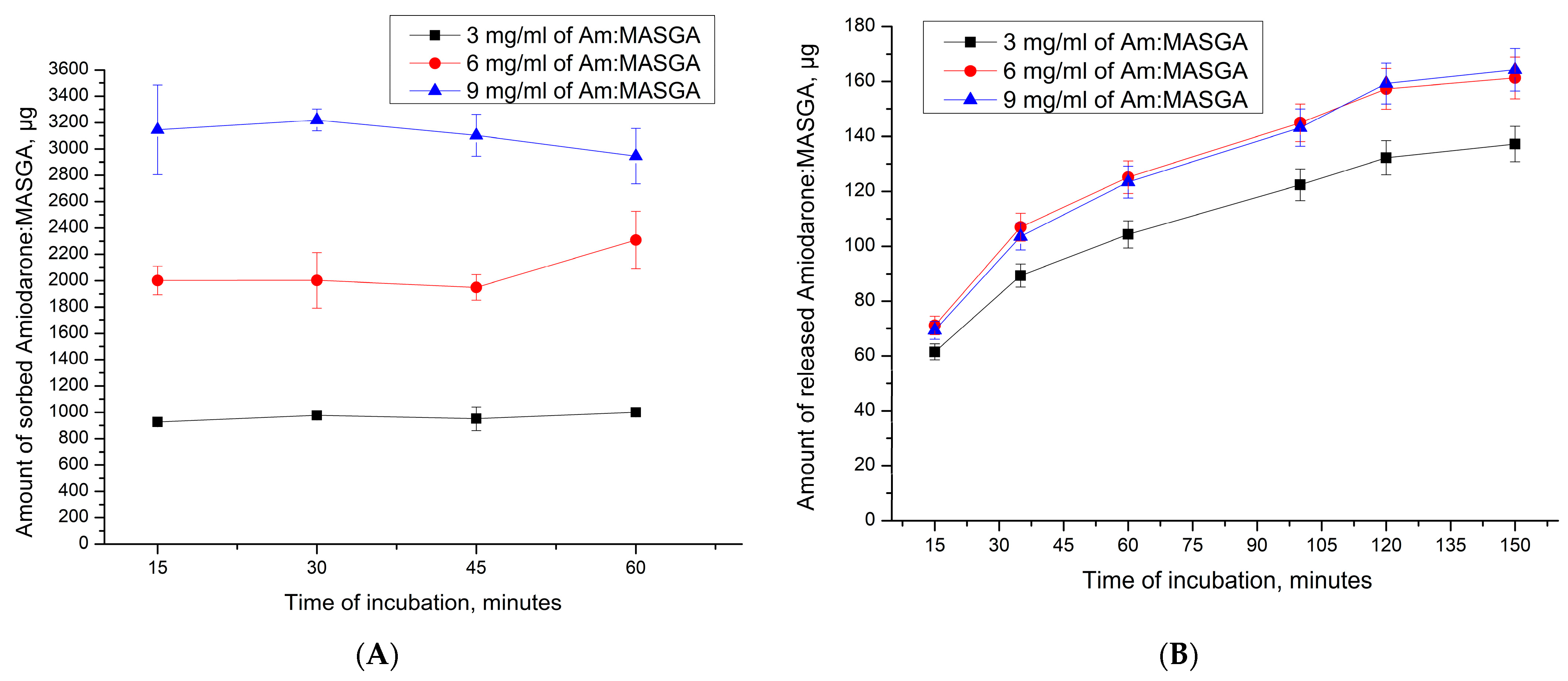
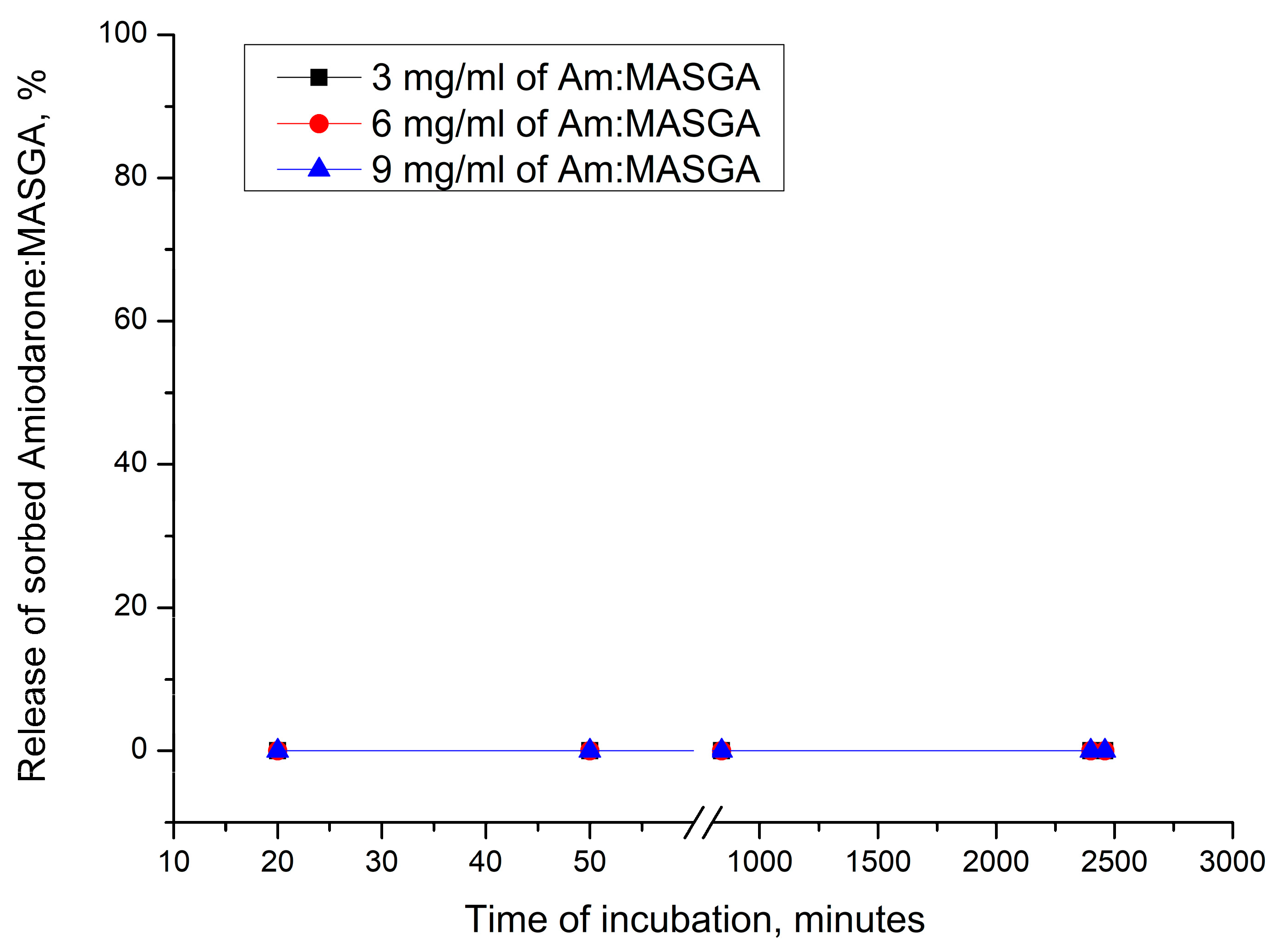
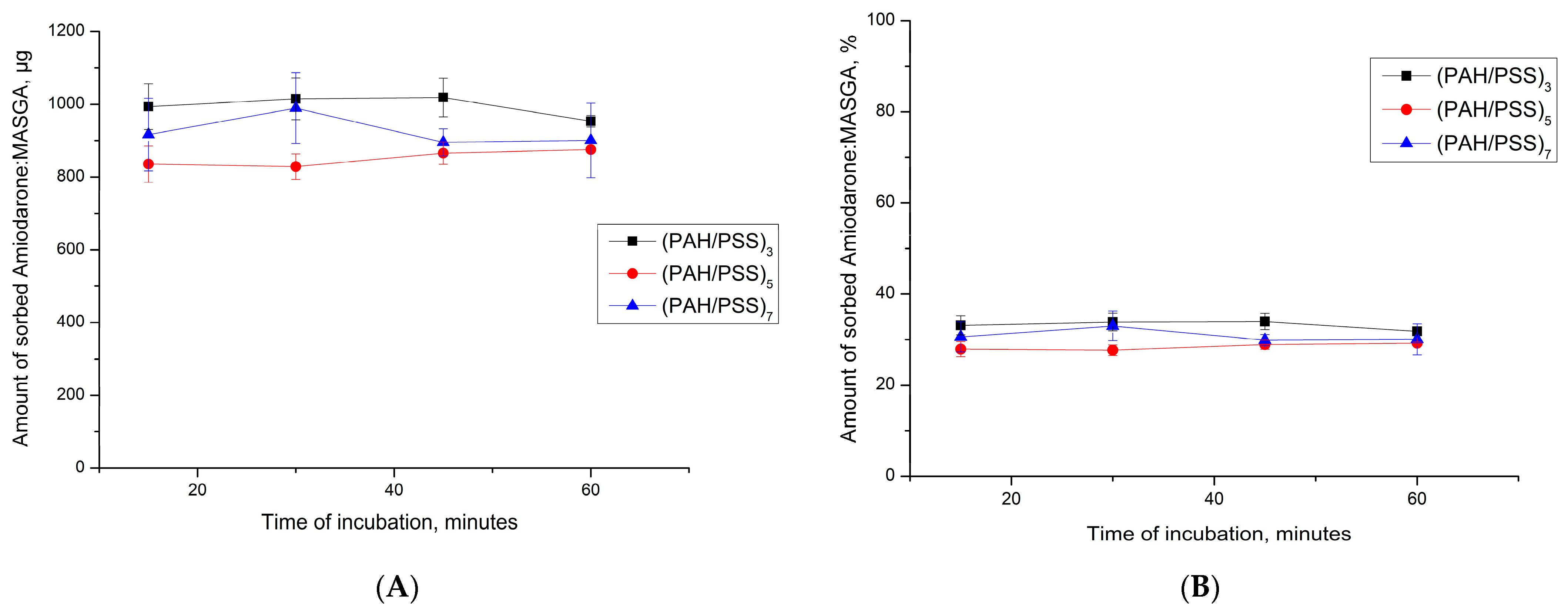
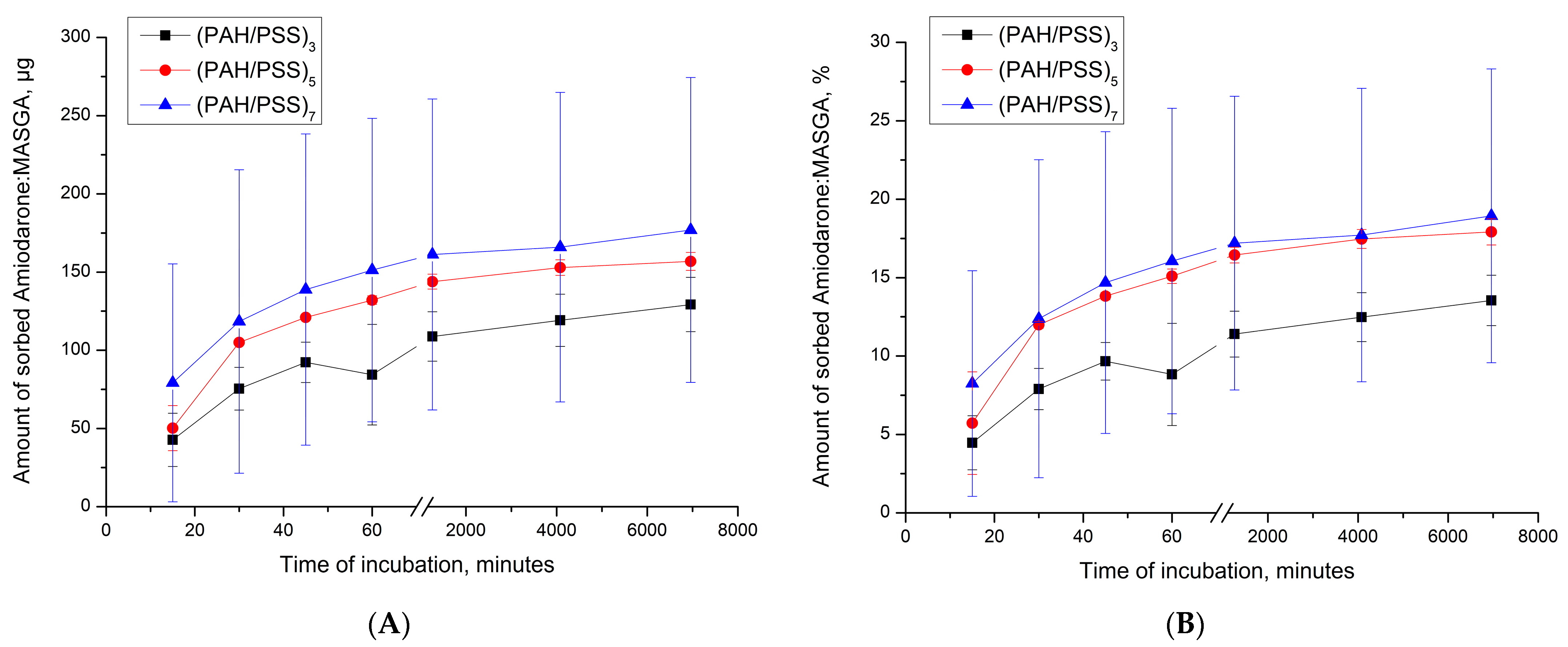
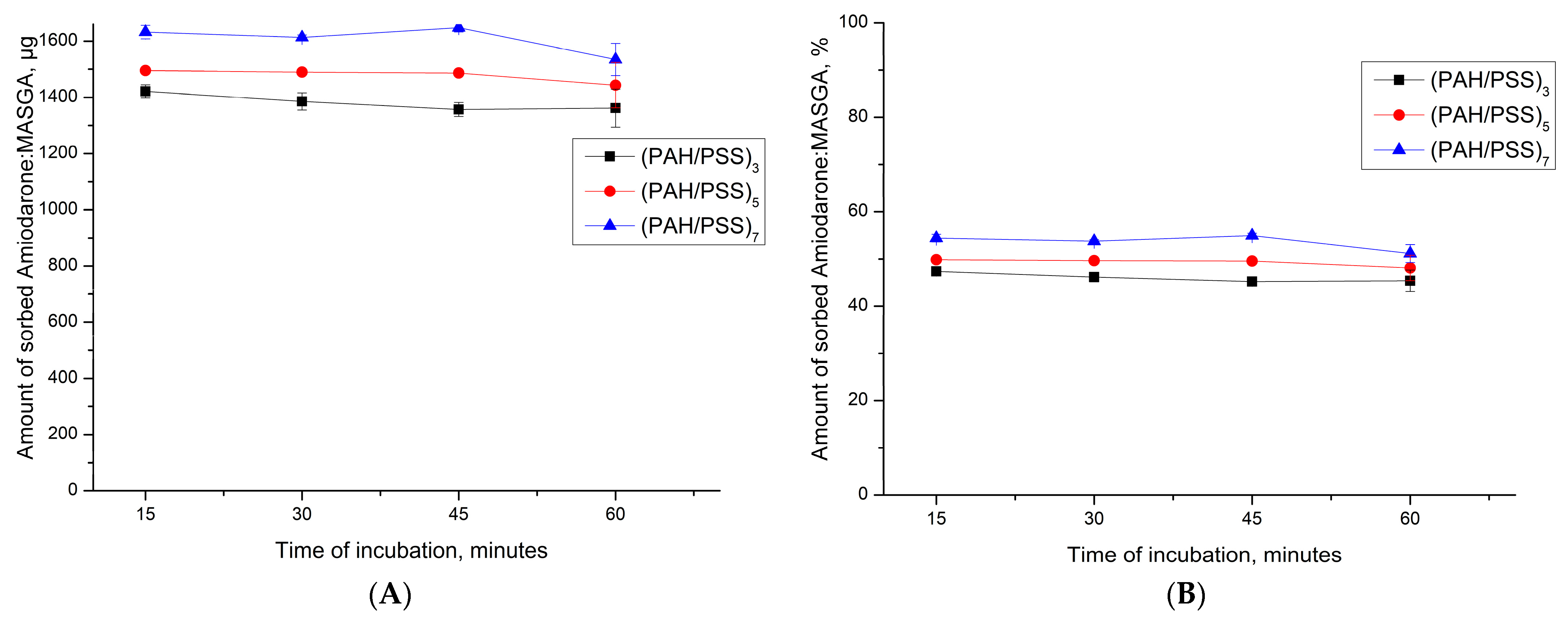
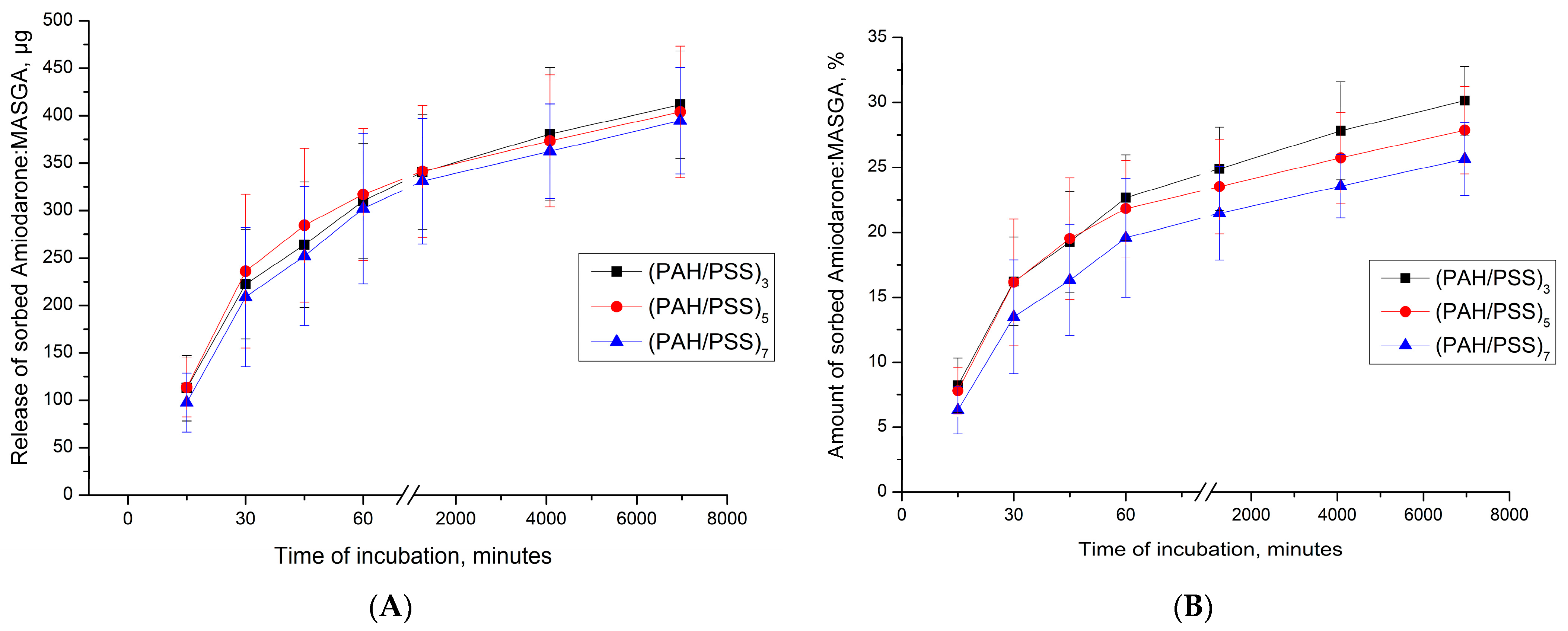
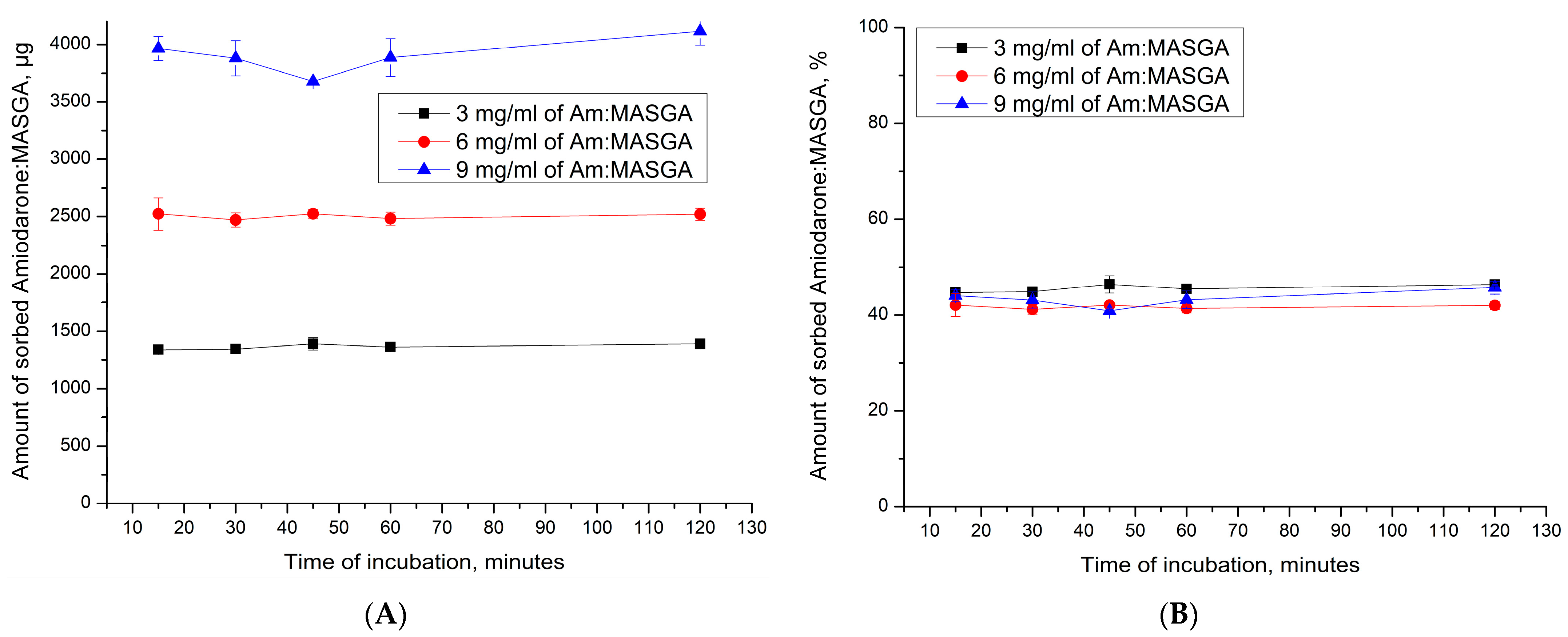
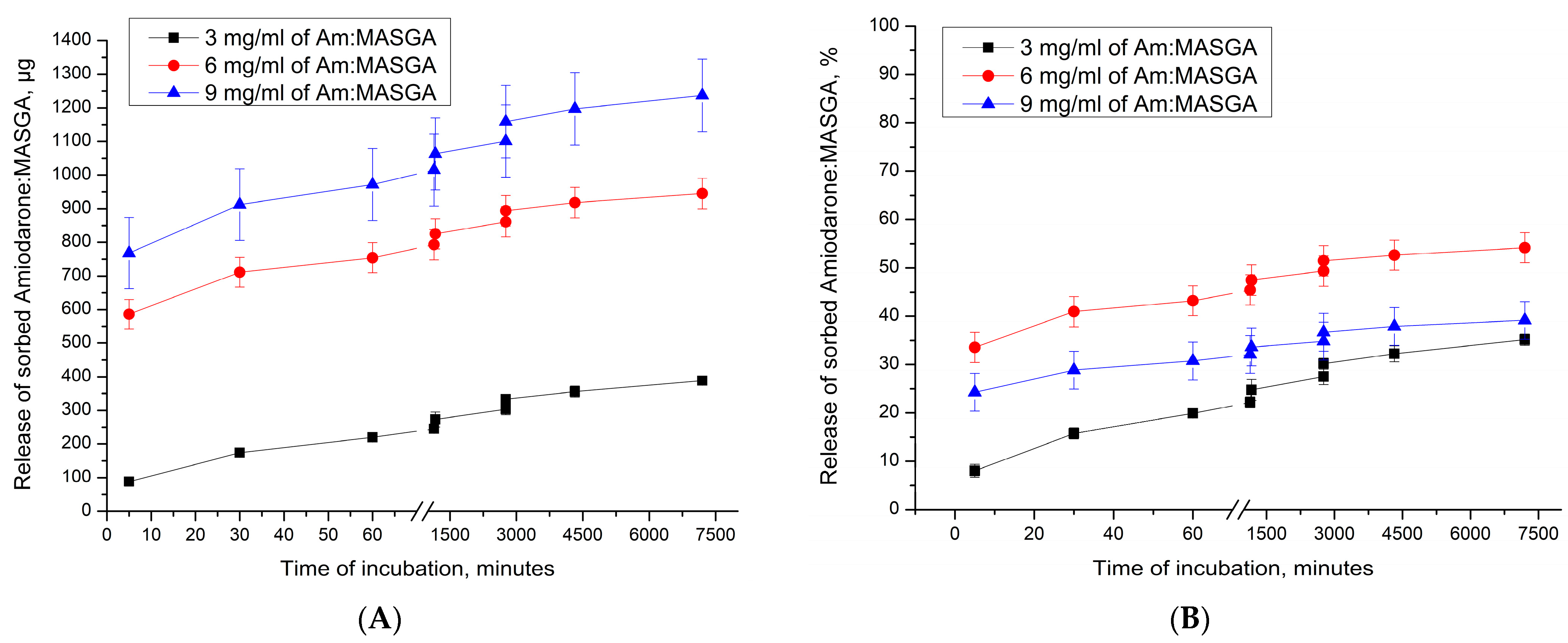

Disclaimer/Publisher’s Note: The statements, opinions and data contained in all publications are solely those of the individual author(s) and contributor(s) and not of MDPI and/or the editor(s). MDPI and/or the editor(s) disclaim responsibility for any injury to people or property resulting from any ideas, methods, instructions or products referred to in the content. |
© 2023 by the authors. Licensee MDPI, Basel, Switzerland. This article is an open access article distributed under the terms and conditions of the Creative Commons Attribution (CC BY) license (https://creativecommons.org/licenses/by/4.0/).
Share and Cite
Kim, A.L.; Musin, E.V.; Oripova, M.J.; Oshchepkova, Y.I.; Salikhov, S.I.; Tikhonenko, S.A. Polyelectrolyte Microcapsules—A Promising Target Delivery System of Amiodarone with the Possibility of Prolonged Release. Int. J. Mol. Sci. 2023, 24, 3348. https://doi.org/10.3390/ijms24043348
Kim AL, Musin EV, Oripova MJ, Oshchepkova YI, Salikhov SI, Tikhonenko SA. Polyelectrolyte Microcapsules—A Promising Target Delivery System of Amiodarone with the Possibility of Prolonged Release. International Journal of Molecular Sciences. 2023; 24(4):3348. https://doi.org/10.3390/ijms24043348
Chicago/Turabian StyleKim, Aleksandr L., Egor V. Musin, Munojat J. Oripova, Yulia I. Oshchepkova, Shavkat I. Salikhov, and Sergey A. Tikhonenko. 2023. "Polyelectrolyte Microcapsules—A Promising Target Delivery System of Amiodarone with the Possibility of Prolonged Release" International Journal of Molecular Sciences 24, no. 4: 3348. https://doi.org/10.3390/ijms24043348
APA StyleKim, A. L., Musin, E. V., Oripova, M. J., Oshchepkova, Y. I., Salikhov, S. I., & Tikhonenko, S. A. (2023). Polyelectrolyte Microcapsules—A Promising Target Delivery System of Amiodarone with the Possibility of Prolonged Release. International Journal of Molecular Sciences, 24(4), 3348. https://doi.org/10.3390/ijms24043348






